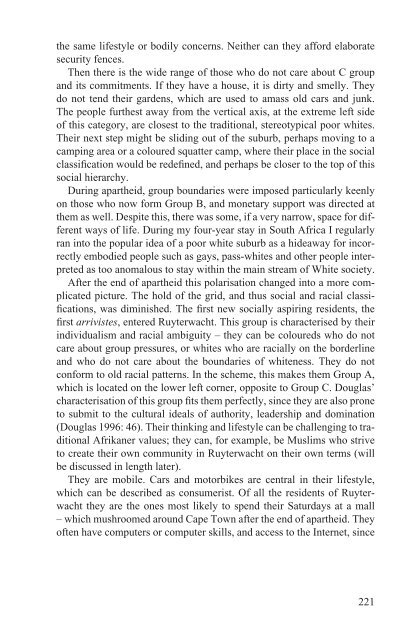The Making of a Good White - E-thesis - Helsinki.fi
The Making of a Good White - E-thesis - Helsinki.fi
The Making of a Good White - E-thesis - Helsinki.fi
You also want an ePaper? Increase the reach of your titles
YUMPU automatically turns print PDFs into web optimized ePapers that Google loves.
the same lifestyle or bodily concerns. Neither can they afford elaborate<br />
security fences.<br />
<strong>The</strong>n there is the wide range <strong>of</strong> those who do not care about C group<br />
and its commitments. If they have a house, it is dirty and smelly. <strong>The</strong>y<br />
do not tend their gardens, which are used to amass old cars and junk.<br />
<strong>The</strong> people furthest away from the vertical axis, at the extreme left side<br />
<strong>of</strong> this category, are closest to the traditional, stereotypical poor whites.<br />
<strong>The</strong>ir next step might be sliding out <strong>of</strong> the suburb, perhaps moving to a<br />
camping area or a coloured squatter camp, where their place in the social<br />
classi<strong>fi</strong>cation would be rede<strong>fi</strong>ned, and perhaps be closer to the top <strong>of</strong> this<br />
social hierarchy.<br />
During apartheid, group boundaries were imposed particularly keenly<br />
on those who now form Group B, and monetary support was directed at<br />
them as well. Despite this, there was some, if a very narrow, space for different<br />
ways <strong>of</strong> life. During my four-year stay in South Africa I regularly<br />
ran into the popular idea <strong>of</strong> a poor white suburb as a hideaway for incorrectly<br />
embodied people such as gays, pass-whites and other people interpreted<br />
as too anomalous to stay within the main stream <strong>of</strong> <strong>White</strong> society.<br />
After the end <strong>of</strong> apartheid this polarisation changed into a more complicated<br />
picture. <strong>The</strong> hold <strong>of</strong> the grid, and thus social and racial classi<strong>fi</strong>cations,<br />
was diminished. <strong>The</strong> <strong>fi</strong>rst new socially aspiring residents, the<br />
<strong>fi</strong>rst arrivistes, entered Ruyterwacht. This group is characterised by their<br />
individualism and racial ambiguity – they can be coloureds who do not<br />
care about group pressures, or whites who are racially on the borderline<br />
and who do not care about the boundaries <strong>of</strong> whiteness. <strong>The</strong>y do not<br />
conform to old racial patterns. In the scheme, this makes them Group A,<br />
which is located on the lower left corner, opposite to Group C. Douglas’<br />
characterisation <strong>of</strong> this group <strong>fi</strong>ts them perfectly, since they are also prone<br />
to submit to the cultural ideals <strong>of</strong> authority, leadership and domination<br />
(Douglas 1996: 46). <strong>The</strong>ir thinking and lifestyle can be challenging to traditional<br />
Afrikaner values; they can, for example, be Muslims who strive<br />
to create their own community in Ruyterwacht on their own terms (will<br />
be discussed in length later).<br />
<strong>The</strong>y are mobile. Cars and motorbikes are central in their lifestyle,<br />
which can be described as consumerist. Of all the residents <strong>of</strong> Ruyterwacht<br />
they are the ones most likely to spend their Saturdays at a mall<br />
– which mushroomed around Cape Town after the end <strong>of</strong> apartheid. <strong>The</strong>y<br />
<strong>of</strong>ten have computers or computer skills, and access to the Internet, since<br />
221
















